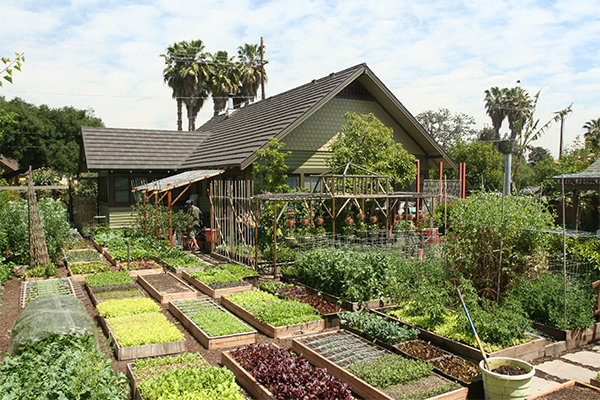In 1985 we bought a run-down circa 1917 craftsman-style house in the metropolis of Pasadena (the 7th largest city in Los Angeles County) which is just 15 minutes from downtown Los Angeles and is located between the intersection of 134 and 210 freeways 30 yards from our home.
Downsizing from rural 10 acres to suburban 1/10 acre, we thought we’d have to put aside our “country” lifestyle. But, try as the city life may, it couldn’t take our country ways. Instead, we decided to bring our country homesteading lifestyle to our urban plot.
No one thought it was possible – not even us (at the start). We forged ahead and with no small means of blood, sweat and tears, we worked to transform this ordinary 66′ x 132′ [ SEE: Comparison Diagram of Property ] urban plot into an extraordinary example of homesteading in the city.
Despite its size, the Urban Homestead project is a fully functioning urban farm in every way (although, some of us believe it should more aptly be described as a 10-ring circus) and it supplies our family with 6,000 pounds of organic produce annually.
We recently upped our production to 7,000 pounds harvested (in 2010). 90% of our vegetarian diet comes from the garden so we eat on almost $2.00 per day per person. [ SEE: Harvest Chart & 6,000 lb Harvest Breakdown ]

Urban Homestead Backyard Farm (2009)
We are living off the land “directly” — supplying our diet, and “indirectly” — we sell the excess harvest to local establishments and individuals through a customized CSA program via our Front Porch Farmstand.
With 7,000lbs harvested…90% of our vegetarian diet comes from the garden so we eat on almost $2.00 per day per person.
Having found food security in our own backyard, we were emboldened to take further steps. We began powering our home with alternative energies and fueling our car with home-brewed bio-diesel.
Along with new technologies, we also embraced the simple living of past generations: we keep farm animals for egg production and manure, cultivate honeybees, use secondhand goods to decrease our consumption of earth’s nonrenewable resources, and continually teach ourselves a variety of back-to-basics skills through “re-skilling”.
We hoped that by documenting our personal experiences we could offer encouragement to those striving to live a simpler, more self-sufficient lifestyle and could help create a new model for urban living.
The Urban Homestead is a successful one-of-a-kind model for sustainable agriculture in urban areas…
Since 2001, our blog “Little Homestead in the City,” shares the first-hand stories of our struggles and joys, defeats and successes of our homesteading journey.
The journey is ongoing— there are steps forward and often steps backward— But the apt focus to keep in mind is Longfellow’s wise words in his classic poem “A Psalm of Life” and that is: learn to labor.. and to wait.”
Through triumphs and struggles, we are indeed blessed and extremely grateful for this “good life,” and, hope that we can inspire you by our efforts shared on this website to take small steps in your own life. Small steps that, collectively, will have an big and lasting impact.
FEATURED ON
Our highly productive Urban Homestead project is now widely considered a successful one-of-a-kind model for sustainable agriculture and eco living in urban areas and has been featured in multiple news medias both nationally and internationally.
With a revival of the modern homestead movement, millions worldwide were inspired to take small steps towards a more sustainable life.
The Urban Homestead project has been featured on thousands of blogs, dozens of tv appearances (Sundance, CBS News, ABC Nightline, Oprah and many more) and hundreds of print articles including, LA Times, NY Times, Times of India, Germany Faz – just to name a few. [view complete list]





